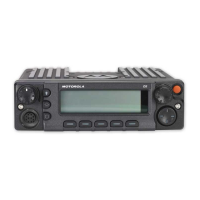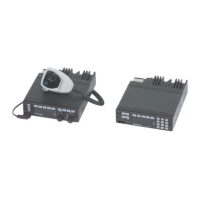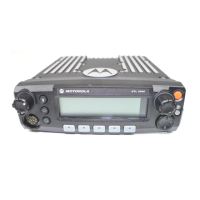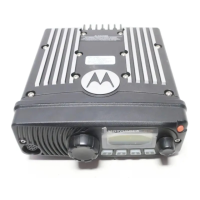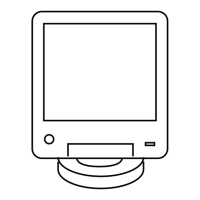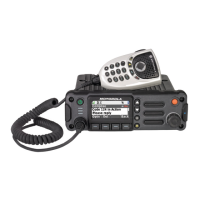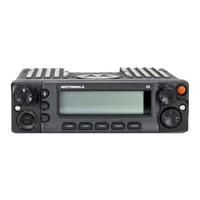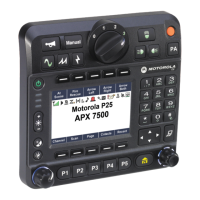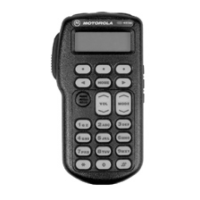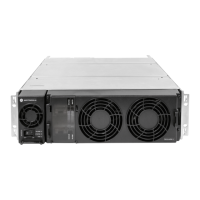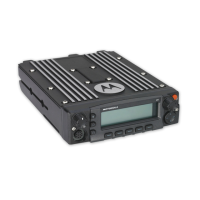6881096C74-B May 25, 2005
Theory of Operation: Controller Section 3-71
3.8.8 Serial Communications on the External Bus (SB9600)
The SB9600 bus is an asynchronous serial communication bus using a Motorola-proprietary
protocol. It provides a means for the microcontroller within the Patriot IC (U100) to communicate with
other hardware devices. In the radio, it communicates with hardware accessories connected to the
accessory connector and the remote interface board. Serial communications on this external bus
uses three of the four SB9600 lines: BUS+ (J0401-31), BUS- (J0401-32), and BUSY (J0401-33) data
lines originating from the microcontroller's secondary UART.
These three lines are bidirectional; therefore, numerous devices can be in parallel on the bus. All
devices monitor the bus while data is being transmitted at a 9600-baud rate. The transmitted data
includes the address of the device for which the data is intended. Examples of the different types of
data are: Button press/release data, sent to and from the radio's microprocessor; control-head
display data; and the existence of accessories on the bus, such as Siren or VRS. The use of these
accessories requires the existence of SB9600 protocol on one of the radio's data buses.
The microcontroller sends the data transmission from UARTB, onto the bus at 0-V and 2.85-V levels.
Next, the software sets microcontroller SB96_RS232_EN to a logic HIGH. Buffers (U0602 and
U0603) are now powered and the data is changed to the SB9600 format via pull-up and pull-down
logic circuitry. SB96_RS232_EN also sets the data MUX (U0606) to route the new SB9600-
formatted data to the correct lines at the front of the radio (J0401-31, J0401-32, J0401-33, and
J0401-34) and to the rear of the radio (J0402-3, J0402-4, J0402-5, and J0402-6). Since
SB96_RS232_EN is kept HIGH as the default state, the UARTB default function is for SB9600 data
traffic only. This is true for the radio in either dash- or remote-mount configuration.
When the microcontroller sends data onto the bus, the microcontroller monitors the transmitted data
as a collision-detection measure. If a collision is detected as a result of receiving a different data
pattern, the microcontroller will stop transmission and try again; that is, when the RESET line
(J0401-34) is used.
Data bus drivers for the BUS+ and BUS- lines are differentially driven, having BUS- inverted from the
state of BUS+. The drivers are so designed that any of the devices on the bus can drive these lines
to their non-idle state without loading problems.
In a typical data transmission, the microcontroller examines the BUSY line. If the BUSY line is in the
idle state, the microcontroller sets the BUSY line HIGH, and then it transmits using BUS+ and BUS-.
At the end of the transmission, the microcontroller returns the BUSY line to idle.
The idle states for the SB9600 lines are: BUS+ = logic HIGH, BUS- = logic LOW, BUSY = logic LOW,
and RESET = logic LOW.
3.8.9 Serial Peripheral Interface (SPI) Bus
The microcontroller (U100) utilizes an SPI bus for configuring and operating specific ICs in the
controller and RF sections of the radio. The SPI bus is a synchronous serial bus made up of four
lines (see Figure 3-48 on page 3-72). The CLK line is used to control the speed of the data to/from
the IC and the microcontroller. If necessary, this clock speed can be adjusted to a different value for
each IC.
The Data-OUT pin receives a data string from the microcontroller. The Data-IN pin sends a serial
data string to the microcontroller, usually to indicate what the current programmed values are of the
IC. The Chip Select pin is used to select which single IC is currently being programmed. Each ICs
Chip Select pin is hardwired to a specific SPI bus and can only be controlled by that bus. The
microcontroller pulls the ICs chip-select line LOW to enable the IC for receiving configuration data,
for programming, or for sending out its existing configuration state. Additional SPI buses allow chip
selecting to occur in parallel. Therefore, the operations on each SPI bus do not add any delay to the
activities occurring on another SPI bus.
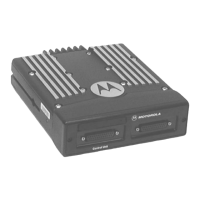
